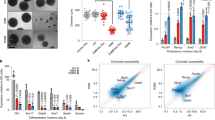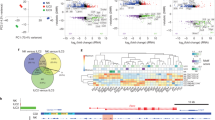Abstract
The 'histone-code' hypothesis proposes that cell fate 'decisions' are achieved through the creation of stable epigenetic histone 'marks' at gene loci. Here we explored the formation of marks of repressive methylation of histone 3 at lysine 9 (H3-K9) and of H3-K27 at the locus encoding interferon-γ (Ifng locus) during the commitment of naive T cells to the T helper type 1 (TH1) and TH2 lineages. Methylation of H3-K9 across the Ifng locus was rapidly induced in differentiating TH1 and TH2 cells and was sustained in TH1 cells. In contrast, TH2 differentiation caused loss of methylation of H3-K9 and gain of methylation of H3-K27 by mechanisms dependent on the transcription factors GATA-3 and STAT6. Thus, histone-methylation marks at the Ifng locus are highly dynamic, which may ensure higher-order transcriptional regulation during early lineage commitment.
This is a preview of subscription content, access via your institution
Access options
Subscribe to this journal
Receive 12 print issues and online access
$209.00 per year
only $17.42 per issue
Buy this article
- Purchase on Springer Link
- Instant access to full article PDF
Prices may be subject to local taxes which are calculated during checkout








Similar content being viewed by others
References
vanHolde, K.E. Chromatin (Springer Verlag, New York, 1988).
Berger, S.L. Histone modifications in transcriptional regulation. Curr. Opin. Genet. Dev. 12, 142–148 (2002).
Margueron, R., Trojer, P. & Reinberg, D. The key to development: interpreting the histone code? Curr. Opin. Genet. Dev. 15, 163–176 (2005).
Vakoc, C.R., Mandat, S.A., Olenchock, B.A. & Blobel, G.A. Histone H3 lysine 9 methylation and HP1γ are associated with transcription elongation through mammalian chromatin. Mol. Cell 19, 381–391 (2005).
Santos-Rosa, H. et al. Active genes are tri-methylated at K4 of histone H3. Nature 419, 407–411 (2002).
Bernstein, B.E. et al. A bivalent chromatin structure marks key developmental genes in embryonic stem cells. Cell 125, 315–326 (2006).
Lindroth, A.M. et al. Dual histone H3 methylation marks at lysines 9 and 27 required for interaction with CHROMOMETHYLASE3. EMBO J. 23, 4286–4296 (2004).
Dutnall, R.N. Cracking the histone code: one, two, three methyls, you're out!. Mol. Cell 12, 3–4 (2003).
Turner, B.M. Cellular memory and the histone code. Cell 111, 285–291 (2002).
Strahl, B.D. & Allis, C.D. The language of covalent histone modifications. Nature 403, 41–45 (2000).
Zhou, W., Chang, S. & Aune, T.M. Long-range histone acetylation of the Ifng gene is an essential feature of T cell differentiation. Proc. Natl. Acad. Sci. USA 101, 2440–2445 (2004).
Chang, S. & Aune, T.M. Histone hyperacetylated domains across the Ifng gene region in natural killer cells and T cells. Proc. Natl. Acad. Sci. USA 102, 17095–17100 (2005).
Forsberg, E.C. et al. Developmentally dynamic histone acetylation pattern of a tissue-specific chromatin domain. Proc. Natl. Acad. Sci. USA 97, 14494–14499 (2000).
Su, R.C. et al. Dynamic assembly of silent chromatin during thymocyte maturation. Nat. Genet. 36, 502–506 (2004).
Calestagne-Morelli, A. & Ausio, J. Long-range histone acetylation: biological significance, structural implications, and mechanisms. Biochem. Cell Biol. 84, 518–527 (2006).
Papp, B. & Muller, J. Histone trimethylation and the maintenance of transcriptional ON and OFF states by trxG and PcG proteins. Genes Dev. 20, 2041–2054 (2006).
Eivazova, E.R. & Aune, T.M. Dynamic alterations in the conformation of the Ifng gene region during T helper cell differentiation. Proc. Natl. Acad. Sci. USA 101, 251–256 (2004).
Kahn, T.G., Schwartz, Y.B., Dellino, G.I. & Pirrotta, V. Polycomb complexes and the propagation of the methylation mark at the Drosophila ubx gene. J. Biol. Chem. 281, 29064–29075 (2006).
Forsberg, E.C. & Bresnick, E.H. Histone acetylation beyond promoters: long-range acetylation patterns in the chromatin world. Bioessays 23, 820–830 (2001).
Ansel, K.M., Lee, D.U. & Rao, A. An epigenetic view of helper T cell differentiation. Nat. Immunol. 4, 616–623 (2003).
Lee, G.R., Kim, S.T., Spilianakis, C.G., Fields, P.E. & Flavell, R.A. T helper cell differentiation: regulation by cis elements and epigenetics. Immunity 24, 369–379 (2006).
Szabo, S.J., Sullivan, B.M., Peng, S.L. & Glimcher, L.H. Molecular mechanisms regulating Th1 immune responses. Annu. Rev. Immunol. 21, 713–758 (2003).
Wilson, C.B. & Merkenschlager, M. Chromatin structure and gene regulation in T cell development and function. Curr. Opin. Immunol. 18, 143–151 (2006).
Grogan, J.L. et al. Early transcription and silencing of cytokine genes underlie polarization of T helper cell subsets. Immunity 14, 205–215 (2001).
Szabo, S.J. et al. A novel transcription factor, T-bet, directs Th1 lineage commitment. Cell 100, 655–669 (2000).
Zheng, W. & Flavell, R.A. The transcription factor GATA-3 is necessary and sufficient for Th2 cytokine gene expression in CD4 T cells. Cell 89, 587–596 (1997).
Thierfelder, W.E. et al. Requirement for Stat4 in interleukin-12-mediated responses of natural killer and T cells. Nature 382, 171–174 (1996).
Avni, O. et al. TH cell differentiation is accompanied by dynamic changes in histone acetylation of cytokine genes. Nat. Immunol. 3, 643–651 (2002).
Agarwal, S. & Rao, A. Modulation of chromatin structure regulates cytokine gene expression during T cell differentiation. Immunity 9, 765–775 (1998).
Baguet, A. & Bix, M. Chromatin landscape dynamics of the Il4-Il13 locus during T helper 1 and 2 development. Proc. Natl. Acad. Sci. USA 101, 11410–11415 (2004).
Yamashita, M. et al. Identification of a conserved GATA3 response element upstream proximal from the interleukin-13 gene locus. J. Biol. Chem. 277, 42399–42408 (2002).
Fields, P.E., Kim, S.T. & Flavell, R.A. Cutting edge: changes in histone acetylation at the IL-4 and IFN-γ loci accompany Th1/Th2 differentiation. J. Immunol. 169, 647–650 (2002).
Schubert, D. et al. Silencing by plant Polycomb-group genes requires dispersed trimethylation of histone H3 at lysine 27. EMBO J. 25, 4638–4649 (2006).
Mohd-Sarip, A. et al. Architecture of a polycomb nucleoprotein complex. Mol. Cell 24, 91–100 (2006).
Ringrose, L., Ehret, H. & Paro, R. Distinct contributions of histone H3 lysine 9 and 27 methylation to locus-specific stability of polycomb complexes. Mol. Cell 16, 641–653 (2004).
Felsenstein, J. & Churchill, G.A. A Hidden Markov Model approach to variation among sites in rate of evolution. Mol. Biol. Evol. 13, 93–104 (1996).
Siepel, A. et al. Evolutionarily conserved elements in vertebrate, insect, worm, and yeast genomes. Genome Res. 15, 1034–1050 (2005).
Xu, X., Sun, Y.L. & Hoey, T. Cooperative DNA binding and sequence-selective recognition conferred by the STAT amino-terminal domain. Science 273, 794–797 (1996).
Laible, G. et al. Mammalian homologues of the Polycomb-group gene Enhancer of zeste mediate gene silencing in Drosophila heterochromatin and at S. cerevisiae telomeres. EMBO J. 16, 3219–3232 (1997).
Ringrose, L. & Paro, R. Epigenetic regulation of cellular memory by the Polycomb and Trithorax group proteins. Annu. Rev. Genet. 38, 413–443 (2004).
Yao, Y.L., Yang, W.M. & Seto, E. Regulation of transcription factor YY1 by acetylation and deacetylation. Mol. Cell. Biol. 21, 5979–5991 (2001).
Caretti, G., Di Padova, M., Micales, B., Lyons, G.E. & Sartorelli, V. The Polycomb Ezh2 methyltransferase regulates muscle gene expression and skeletal muscle differentiation. Genes Dev. 18, 2627–2638 (2004).
Soutto, M. et al. A minimal IFN-gamma promoter confers Th1 selective expression. J. Immunol. 169, 4205–4212 (2002).
Ye, J., Cippitelli, M., Dorman, L., Ortaldo, J.R. & Young, H.A. The nuclear factor YY1 suppresses the human γ interferon promoter through two mechanisms: inhibition of AP1 binding and activation of a silencer element. Mol. Cell. Biol. 16, 4744–4753 (1996).
Usui, T. et al. T-bet regulates Th1 responses through essential effects on GATA-3 function rather than on IFNG gene acetylation and transcription. J. Exp. Med. 203, 755–766 (2006).
Hwang, E.S., Szabo, S.J., Schwartzberg, P.L. & Glimcher, L.H. T helper cell fate specified by kinase-mediated interaction of T-bet with GATA-3. Science 307, 430–433 (2005).
Koyanagi, M. et al. EZH2 and histone 3 trimethyl lysine 27 associated with Il4 and Il13 gene silencing in Th1 cells. J. Biol. Chem. 280, 31470–31477 (2005).
Dermitzakis, E.T., Reymond, A. & Antonarakis, S.E. Conserved non-genic sequences - an unexpected feature of mammalian genomes. Nat. Rev. Genet. 6, 151–157 (2005).
Hatton, R.D. et al. A distal conserved sequence element controls Ifng gene expression by T cells and NK cells. Immunity 25, 717–729 (2006).
Rodriguez-Galan, M.C., Bream, J.H., Farr, A. & Young, H.A. Synergistic effect of IL-2, IL-12, and IL-18 on thymocyte apoptosis and Th1/Th2 cytokine expression. J. Immunol. 174, 2796–2804 (2005).
Lee, D.U., Avni, O., Chen, L. & Rao, A. A distal enhancer in the interferon-γ (IFN-γ) locus revealed by genome sequence comparison. J. Biol. Chem. 279, 4802–4810 (2004).
Shnyreva, M. et al. Evolutionarily conserved sequence elements that positively regulate IFN-γ expression in T cells. Proc. Natl. Acad. Sci. USA 101, 12622–12627 (2004).
Soutto, M., Zhou, W. & Aune, T.M. Cutting edge: distal regulatory elements are required to achieve selective expression of IFN-γ in Th1/Tc1 effector cells. J. Immunol. 169, 6664–6667 (2002).
Ouyang, W. et al. Inhibition of Th1 development mediated by GATA-3 through an IL-4-independent mechanism. Immunity 9, 745–755 (1998).
Acknowledgements
We thank E.M. Oltz for comments and review of the manuscript. Supported by the National Institutes of Health (AI 44924).
Author information
Authors and Affiliations
Contributions
S.C. and T.M.A. contributed to discussions, experimental design, data analysis, execution of experiments and preparation of the manuscript.
Note: Supplementary information is available on the Nature Immunology website.
Corresponding author
Ethics declarations
Competing interests
The authors declare no competing financial interests.
Supplementary information
Supplementary Fig. 1
Kinetics of Ifng mRNA and IFN-γ protein expression following T cell stimulation. (PDF 269 kb)
Supplementary Fig. 2
EZH2 recruitment to the Ifng locus in developing TH1 and TH2 cells. (PDF 251 kb)
Supplementary Table 1
Primer sequences used for ChIP analysis. (PDF 48 kb)
Rights and permissions
About this article
Cite this article
Chang, S., Aune, T. Dynamic changes in histone-methylation 'marks' across the locus encoding interferon-γ during the differentiation of T helper type 2 cells. Nat Immunol 8, 723–731 (2007). https://doi.org/10.1038/ni1473
Received:
Accepted:
Published:
Issue Date:
DOI: https://doi.org/10.1038/ni1473
This article is cited by
-
The Correlation Between IFNG Gene Methylation and Th1|Th2 Cell Balance in ROU and the Interventional Study of Jiaweidaochi Powder
Applied Biochemistry and Biotechnology (2023)
-
Immune network dysregulation precedes clinical diagnosis of asthma
Scientific Reports (2020)
-
Targeting p53 and histone methyltransferases restores exhausted CD8+ T cells in HCV infection
Nature Communications (2020)
-
Transcription factors STAT-4, STAT-6 and CREB regulate Th1/Th2 response in leprosy patients: effect of M. leprae antigens
BMC Infectious Diseases (2019)
-
Juvenile idiopathic arthritis associated with a mutation in GATA3
Arthritis Research & Therapy (2019)



